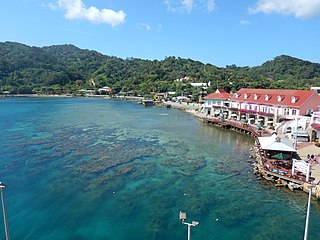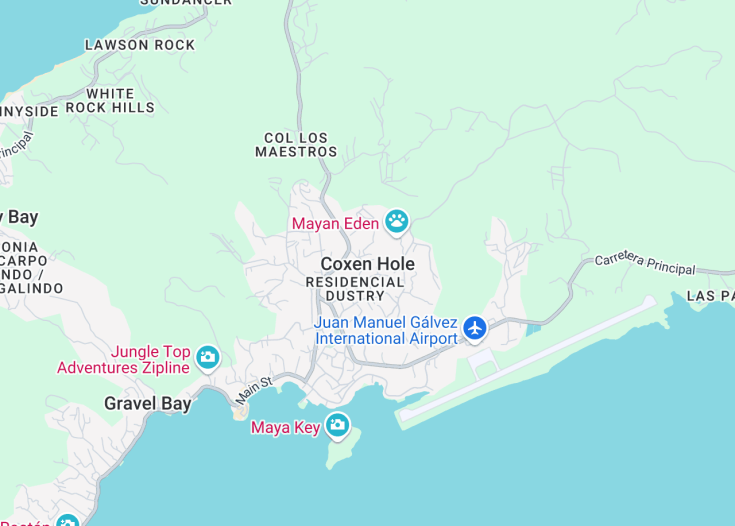Coxen Hole, the largest town on the charming island of Roatán in Honduras, serves as a welcoming gateway for travelers exploring the Caribbean. Renowned for its rich history linked to pirates and colonial trades, today it offers a blend of vibrant cultural experiences and natural beauty. The town boasts a bustling main street lined with quaint shops, local eateries, and a friendly ambiance. Nearby, one can enjoy white sandy beaches and pristine coral reefs, perfect for diving and snorkeling enthusiasts seeking adventure in unspoilt waters.
To make the most of your visit to Coxen Hole, consider exploring during the early morning to avoid the heat and experience the town as it wakes. This is also the best time for photography, with fewer tourists and soft light.
When planning a trip to Coxen Hole, include a guided tour that reveals the history and cultural heritage of the area. Knowledgeable local guides can provide insights not typically found in guidebooks.
Top things to do & see in Coxen Hole (Roatán)
Select the following sights and activities to discover best tickets and tours available in Coxen Hole (Roatán).
Coxen Hole: A Tropical Gateway
| Country | Honduras |
| Time in Coxen Hole | GMT-6 |
| Language spoken | Spanish |
| Population | 8,307 (2021 census) |
| Currency | Honduran lempira (HNL ₲) |
| Airports | Juan Manuel Gálvez International Airport (1 mi / 1.6 km). |
Located on the largest of the Bay Islands, Coxen Hole in Honduras is a vibrant port town that serves as the administrative capital of Roatán. Often overshadowed by its more tourist-centric neighbors, Coxen Hole offers a slice of authentic island life mixed with colonial history. Here, locals and visitors alike mingle along bustling streets where colorful markets, local eateries, and quaint shops paint a lively picture of daily life.
The history of Coxen Hole is steeped in piracy and colonial trade. The town is named after the pirate John Coxen who used the surrounding waters to launch attacks in the 17th century. Today, Coxen Hole is known for its rich cultural tapestry, which is made visible through its vibrant celebrations, such as the annual carnival. This event demonstrates the local zest for life with elaborate parades, traditional music, and dance that spill into the streets, creating a spectacle of colors and sounds that draw people from all over the island.
The economic pulse of the town thrives on tourism, fishing, and the export of local goods like seafood and agricultural products. The improvement of transport facilities, including the near Juan Manuel Gálvez International Airport, has significantly enabled better connectivity and contributed to the town’s economic resilience. The town is also a crucial point for understanding the ecosystem of the Mesoamerican Barrier Reef through sustainable tourism practices that highlight conservation efforts and educate visitors about the environment.
Coxen Hole maintains its charm amidst modernization and is an essential destination for those interested in experiencing a less commercialized side of Caribbean life. Its strategic location makes it a perfect starting point for exploring the natural beauties of Roatán, making it a must-visit for anyone travelling to Honduras.
Where is Coxen Hole?
Located on the island of Roatán, Honduras, Coxen Hole lies on the Caribbean coast and is directly accessible from the mainland by air or water.
Distances:
| Route | Distance by car | Time by car |
|---|---|---|
| Tegucigalpa to Coxen Hole | 235 mi | Approx. 8h |
| San Pedro Sula to Coxen Hole | 128 mi | Approx. 4h by ferry |
What is Coxen Hole famous for?
Coxen Hole is renowned for its rich history involving pirates and its vibrant local culture. The town’s annual carnival vividly showcases its unique cultural identity through lively music and dance.
History
Pre-Colonial Period (Before 1500)
The area of Coxen Hole, located on the island of Roatán in Honduras, was inhabited by indigenous Paya people long before the arrival of Europeans. These early inhabitants lived a relatively isolated existence, relying on fishing, agriculture, and trade with nearby mainland communities for their survival.
Spanish Colonization (1500s-1800s)
Coxen Hole’s modern history began with the arrival of the Spanish in the 16th century. The island became a focal point for exploration and was intermittently populated by settlers, pirates, and traders. Despite Spanish sovereignty, Coxen Hole saw frequent intrusions by British and Dutch marauders, which led to fluctuating control over the centuries.
The British and Garifuna Influence (1797-1872)
The British Empire exerted control over Roatán and Coxen Hole beginning in the late 18th century. During this period, in 1797, the Garifuna people — descendants of African slaves and indigenous Caribs — were exiled from the British-controlled Saint Vincent to Roatán. They influenced the cultural fabric of Coxen Hole significantly, contributing to its linguistic, culinary, and artistic traditions.
Restoration to Honduras (1872-Present)
In 1872, Coxen Hole and the rest of Roatán were officially annexed back to Honduras. Since then, it has transitioned from a sleepy fishing village to a crucial port and commercial center. In the 20th century, the establishment of tourist infrastructure sparked economic development, transforming Coxen Hole into a vibrant gateway to the island’s many attractions.
Visit Coxen Hole
What to see and do in Coxen Hole, Honduras
Coxen Hole offers a captivating blend of natural beauty and cultural history. Visitors can explore breathtaking beaches and pristine natural reserves. Key attractions include the Roatán Museum, which provides insights into the island’s rich history and culture. The bustling market is ideal for finding unique crafts and fresh local produce. For adventure seekers, diving and snorkeling around the coral reefs are must-do activities.
Festivities in Coxen Hole
Coxen Hole hosts vibrant cultural events, notably the annual Roatán Carnival. Held in April, this event features colorful parades, music, and dance that showcase the island’s diverse heritage. Another significant event is the Garifuna Settlement Day in November, celebrating the arrival of the Garifuna people with traditional music, dance, and ceremonies.
Best time to visit Coxen Hole
The best time to visit Coxen Hole is during the dry season from January to April. This period offers sunny days and lower humidity, providing ideal conditions for exploring the outdoors and participating in the island’s festivities.
is Coxen Hole worth visiting?
Coxen Hole is undoubtedly worth visiting for those intrigued by a unique blend of cultural richness and natural beauty. The area serves as a fascinating historical gateway into the island’s past, presented through its museums, architecture, and community events. Moreover, its scenic landscapes and vibrant marine life offer unforgettable experiences for nature lovers and adventure seekers alike.










